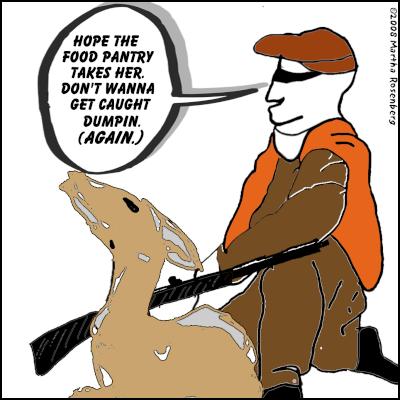Is US Beef At Risk of Mad Cow Disease Again?
Is US Beef At Risk of Mad Cow Disease
Again?
And how about venison?
by Martha
RosenbergIt's been two years since rumors of mad cows in Texas sank cattle futures at the Chicago Mercantile Exchange when a woman with Creutzfeldt-Jakob Disease (CJD), human mad cow disease, was admitted to an Amarillo hospital.
"The rumor was started, and it's totally unfounded, that there were cattle with BSE in Texas," Ted McCollum, beef cattle specialist with the Amarillo office of Texas AgriLife Extension, told the press.
Of course it's easy to see how the rumor got started that there were cattle with BSE in Texas since there were cattle with BSE in Texas.
In 2005, the first "home grown" mad cow was found on a Texas ranch whose identity authorities protected. A 12-year-old beef cow used for breeding, she was sent to Champion Pet Food in Waco when she became a downer. The ranch was quarantined while authorities searched for the animal's offspring and older animals.
Now there are two "mysterious" cases of CJD in McLennan county, Texas says the Waco Tribune-Herald --"a statistical anomaly considering that only one in 1 million people worldwide is affected by the condition in any given year."
The statistical abnormality is also visible on the Texas Department of State Health Services map on its web site. There have been 144 cases of CJD in Texas since 2000 and 42 of them appear in clusters. If CJD is caused for unknown reasons (sporadic) or is familial, it would not come in clusters.
It has been years since the San Francisco Chronicle reported that 11 restaurants in nine California counties served meat from the first US mad cow, imported from Canada in 2003. A subsequent audit of US slaughterhouses to win back Asian exports which were lost over the cow, found 29 more downers slipped into the food supply because some inspectors "did not believe that they had the authority" to go into their pens. But then Secretary Johanns assured the press the cattle were healthy when they arrived at the slaughterhouse but became suddenly unable to walk for one reason or another.
Authorities also gave up tracing origins of the second homegrown US mad cow, born on an Alabama ranch, whose identity authorities also protected. The trail went cold after seven weeks of investigation of more than three dozen farms, said news reports.
In addition to food risks, unacknowledged mad cow in US beef could also be a risk in dental implants, made from bovine and cadaver sources.
And now there is also a cloud over deer and elk which get a mad cow like disease called chronic wasting disease (CWD). Like mad cow, CWD is caused by a practically indestructible protein called a prion which is not killed by cooking, alcohol, bleach, formaldehyde or radiation.
State Departments of Natural Resources thought the disease was under control after directing hunters to kill "anterless" deer instead of bucks, thinning the herd. Food pantries were beginning to accept venison "donations" again after refusing them. ("It's perfectly good meat -- for someone else to eat," the hunters seemed to be saying.)
But now the disease is back with a vengeance, causing hunters to fear the other guy's deer at the processor if not their own, until CWD tests come back, and wives to fear husbands' bloody laundry.
Prions are transmitted in carrier animals' urine and in antler velvet says a January article on PLoS One. Worse, they are likely transmitted from mother to offspring says the article, making US authorities' failure to find the mad cow progeny -- and their progeny -- more disquieting.
CWD is also taking a toll on deer breeding and hunting lodges, a $4 billion a year industry despite state complaints of deer "overpopulation." Wisconsin alone has hundreds of state sanctioned deer breeding farms.
Earlier this year, a deer with CWD was found at Heartland Wildlife Ranches in Ethel, Mo., 200 miles northwest of St. Louis. Heartland is an 800-acre lodge surrounded by 8-foot fences where hunters "come from across the country to take aim at trophy animals such as whitetail deer, elk and zebra," says the St. Louis Post-Dispatch. Think Dick Cheney. A three-day hunt for water buffalo costs $4,000.
In addition to threatening Rob Brasher of Salt Lake City, whose family has owned Heartland for two decades, CWD threatens David Wood, who runs the Linn County deer farm 17 miles from Heartland and can no longer sell his "baby deer" for $4,000 to $8,000.
Luckily, federal and state governments are on the mad cow and CWD case -- protecting industry from consumers' rights to know.
ENDS



 Gordon Campbell: On The Government’s Latest Ferries Scam
Gordon Campbell: On The Government’s Latest Ferries Scam Peter Dunne: Dunne's Weekly - While We're Breaking Up Monoliths, What About MBIE?
Peter Dunne: Dunne's Weekly - While We're Breaking Up Monoliths, What About MBIE? Adrian Maidment: Supermarket Signs
Adrian Maidment: Supermarket Signs Ian Powell: Revisiting Universalism
Ian Powell: Revisiting Universalism Martin LeFevre - Meditations: In A Global Society, There Is No Such Thing As “National Security”
Martin LeFevre - Meditations: In A Global Society, There Is No Such Thing As “National Security” Binoy Kampmark: Secrecy And Virtue Signalling - Another View Of Signalgate
Binoy Kampmark: Secrecy And Virtue Signalling - Another View Of Signalgate